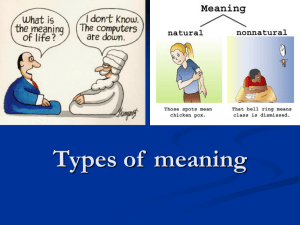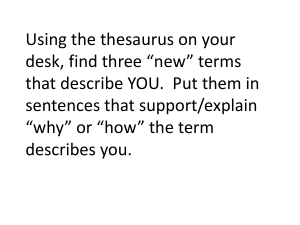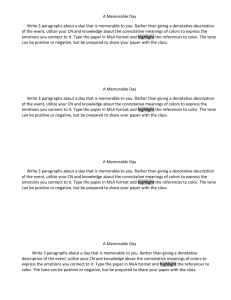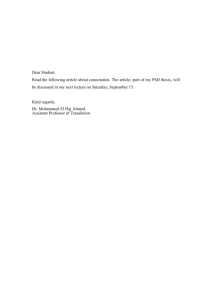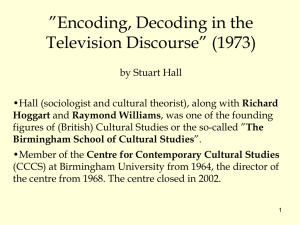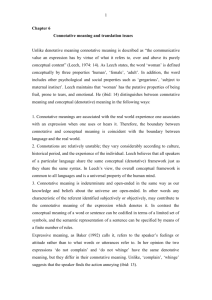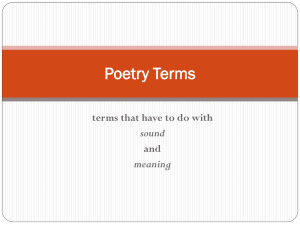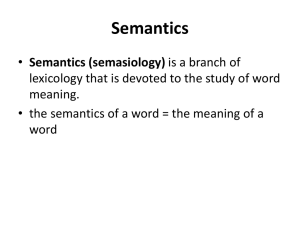mass com 313 readings #9
advertisement
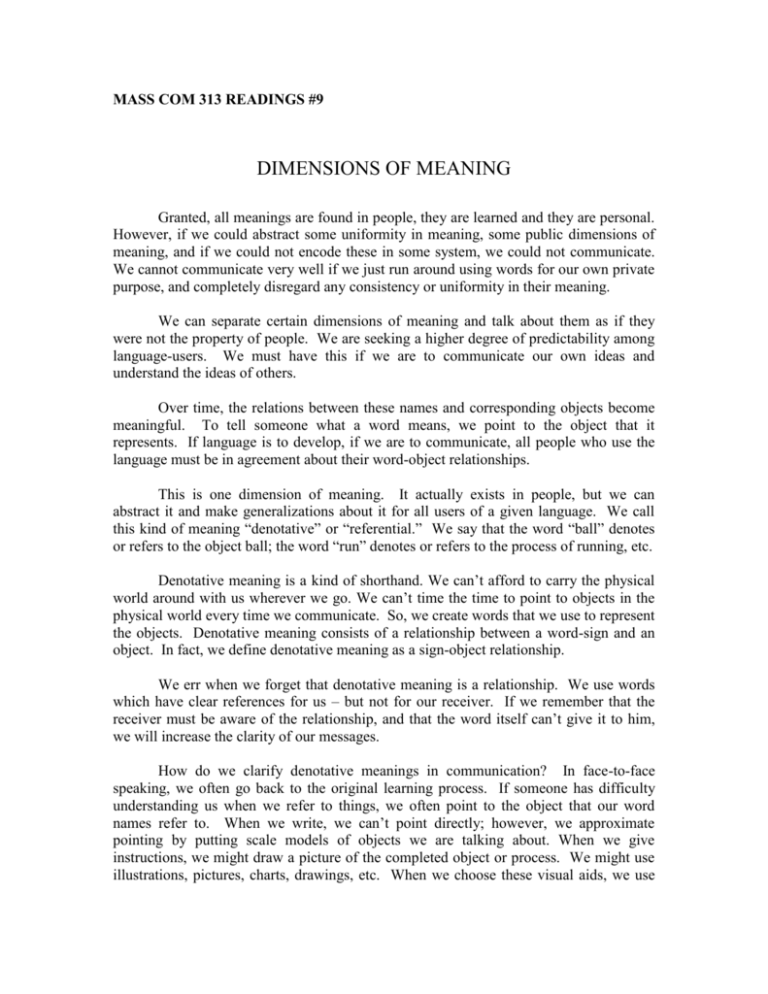
MASS COM 313 READINGS #9 DIMENSIONS OF MEANING Granted, all meanings are found in people, they are learned and they are personal. However, if we could abstract some uniformity in meaning, some public dimensions of meaning, and if we could not encode these in some system, we could not communicate. We cannot communicate very well if we just run around using words for our own private purpose, and completely disregard any consistency or uniformity in their meaning. We can separate certain dimensions of meaning and talk about them as if they were not the property of people. We are seeking a higher degree of predictability among language-users. We must have this if we are to communicate our own ideas and understand the ideas of others. Over time, the relations between these names and corresponding objects become meaningful. To tell someone what a word means, we point to the object that it represents. If language is to develop, if we are to communicate, all people who use the language must be in agreement about their word-object relationships. This is one dimension of meaning. It actually exists in people, but we can abstract it and make generalizations about it for all users of a given language. We call this kind of meaning “denotative” or “referential.” We say that the word “ball” denotes or refers to the object ball; the word “run” denotes or refers to the process of running, etc. Denotative meaning is a kind of shorthand. We can’t afford to carry the physical world around with us wherever we go. We can’t time the time to point to objects in the physical world every time we communicate. So, we create words that we use to represent the objects. Denotative meaning consists of a relationship between a word-sign and an object. In fact, we define denotative meaning as a sign-object relationship. We err when we forget that denotative meaning is a relationship. We use words which have clear references for us – but not for our receiver. If we remember that the receiver must be aware of the relationship, and that the word itself can’t give it to him, we will increase the clarity of our messages. How do we clarify denotative meanings in communication? In face-to-face speaking, we often go back to the original learning process. If someone has difficulty understanding us when we refer to things, we often point to the object that our word names refer to. When we write, we can’t point directly; however, we approximate pointing by putting scale models of objects we are talking about. When we give instructions, we might draw a picture of the completed object or process. We might use illustrations, pictures, charts, drawings, etc. When we choose these visual aids, we use the denotative difficulty of our words as a criterion, i.e., hard words need illustration, easy words do not. For example, if you know no words in English, I can teach you some by using the words, and pointing to their referrants at the same time. This is relatively easy. Suppose I did not point, but merely defined the words in terms of other words. This is not so easy If you know no words in English, you can’t learn from an English dictionary. Denotative meanings are relationships between word-signs and objects that exist in the physical world. When we use words denotatively, we are trying to name something in the physical world. We are saying that (a) something exists, and (b) we are going to talk about it, or at least refer to it. We can say, therefore, that denotative meaning is concerned with physical reality – the existence of objects in the physical world. The domain of denotation is physical reality. Let us turn our attention to another aspect or dimension of meaning. As we progress in our language usage, we find that we want to do more than just name things. To construct sentences, we need some procedures for arranging words in sequences. We want to know how we let people know whether we are talking about today, tomorrow or yesterday. The term “grammar” for many of us refers to the methods of sequencing words. Not rules, merely methods. Grammar does not prescribe a set of “rules;” it describes a set of procedures for arranging language elements in ways which are meaningful for users of that language. In general, there is meaning in the form of language sequences. This kind of meaning doesn’t refer to anything, it doesn’t denote anything, but it does aid us in sorting out meanings, communicating our ideas, and in understanding other people. We can label this second dimension of meaning as “structural.” We get meaning from structure when one-word sign helps us predict another word-sign, or when the sequencing of two-word signs tells us something about their relationship that we couldn’t get from either word by itself. Structural meanings increase our predictive ability. They enable us to predict what is coming, on the basis of what has occurred. They reduce uncertainty. We continually make predictions about what is going to occur. Structural meanings increase our ability to do this. As we learn that the probability of one event occurring is conditioned is conditioned by something else, we can predict more effectively whether the event will occur or not. In summary, structural meaning is found in a relationship between signs and other signs. We said that denotative meaning was a sign-object relationship. Structural meaning is a sign-sign relationship. In order to analyze structural meaning, we don’t have to go into the physical world and find objects that words refer to. We do not have to analyze the formal relationships among words. For this reason, we can say that the domain of structural meaning is formal reality, not physical reality. Let’s turn now to a third approach to a meaning of the word “meaning.” A good many of our meaning never become very public. They remain highly personal. Meanings for some words vary a lot among people. When we use words for which we have meanings, but our meanings are either (a) vague, or (b) extremely personal, we call our meanings “connotative.” Connotative meaning is primitive meaning – it is meaning which has never gone beyond the personal learning stage. True, connotative meaning often is a relationship between a sign and an object, but it involves people more than other meaning does. We define connotative meaning as a relationship between a sign, an object, and a person. Connotative meaning is personoriented. When we use words that are highly connotative, we must take extra care to be sure that our receiver will mean something by them, preferably what we intended him to mean. Connotative meaning is not concerned with physical reality, but with social reality. Connotative meaning is meaning that comes from the personal experiences of the person who uses the word, and is closely related to who and what he is as a person. One kind of example of connotative meaning can be drawn from words which we use as vague approximations, to other words for which we have precise denotative meanings. Take words like “tall,” “short,” and “large.” We can always substitute other words for these – words that have specific referrants; however, substitute words often differ drastically from person to person. Another example of connotative meaning involves words which do not report much about the world, but which tell a great deal about the person using them, since they indicate his values, judgements, attitudes, etc. Words which we label as connotative always tell us something of the state of the organism about the user of that word. There are words such as “good,” “desirable,” “likeable,” “unpleasant” and “beautiful.” These words are very closely tied to the people who use them; therefore, the meanings we have for them vary greatly among people. These words cause us trouble in communication. We use them frequently because we want to put ourselves in our messages; however, if we are not careful, we fail to communicate our intentions precisely to the receiver. Connotative terms do not refer primarily to the quality of an object; they refer to the state of the organism, the responses of the individual perceiving that object. When we say “that is a good show,” we are not describing the show. We are saying that we felt good when we saw the show. In communicating, we use words which have heavy connotative meanings. In doing so, we must be careful to choose words which communicate our intent – or risk being misunderstood. You might even want to test some of the connotative words you use frequently. See if other people’s meanings are at all similar to yours. Denotative and connotative meanings are not different in kind; they differ only in degree. Denotative meanings are simply connotative meanings on which we all agree. In communicating, we utilize all three dimensions of meaning. Take a sentence like “My mother is alive.” What is our meaning of the word “mother?” Well, we can say that is a noun. This is formal meaning, and is derived from the word’s place in the sentence. A second meaning, which we can label as denotative, is the person who bears a highly specific biological relationship to us. Finally, our connotative meaning for the term “my mother” is the sum total of all our previous experiences with (a) our own mothers, (b) other people’s mothers, and (c) all of the situations in which we have used or heard the word “mother.” We can all pretty well agree on the first (structural) meaning, and most of us would agree on the denotative meaning. Important: it is impossible for us ever to agree completely on the connotative meaning. Our experiences always differ from those of other people. In communicating, we should remember that our word and sentence arrangement choices convey meaning in at least three ways. Syntax has utility in that it communicates structural relationships among words, and gives us contextual clues as to which of several meanings is the one intended by the writer. Many of our words denote certain objects for the reader. Other words have little denotative meaning, but are primarily connotative, in that they elicit personal experiences, often judgmental in nature. When we emphasize denotative meanings, and careful structure, we can be more hopeful that we report accurately. When we emphasize connotative meanings, we must realize that other people’s meaning are always slightly different from our own – and often, radically different. The physical fidelity of our communication increases as connotation increases, but often the readability and interest of our messages go up. ###
